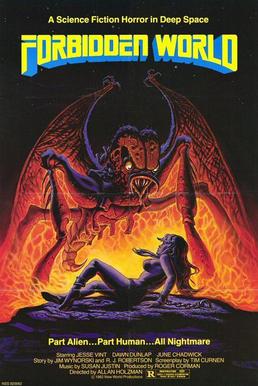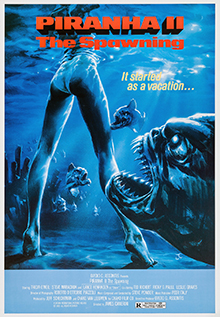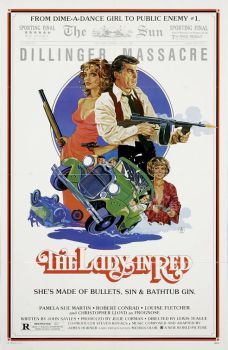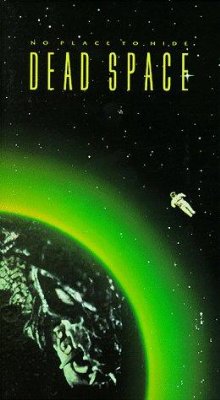
John Thomas Sayles is an American independent film director, screenwriter, editor, actor, and novelist. He is known for writing and directing the films The Brother from Another Planet (1984), Matewan (1987), Eight Men Out (1988), Passion Fish (1992), The Secret of Roan Inish (1994), Lone Star (1996), and Men with Guns (1997).

Roger William Corman was an American film director, producer and actor. Known under various monikers such as "The Pope of Pop Cinema", "The Spiritual Godfather of the New Hollywood", and "The King of Cult", he was known as a trailblazer in the world of independent film.

Joseph James Dante Jr. is an American film director, producer, editor and actor. His films—notably Gremlins (1984) alongside its sequel, Gremlins 2: The New Batch (1990)—often mix the 1950s-style B movie genre with 1960s radicalism and cartoon comedy.

The Brother from Another Planet is a 1984 low-budget American science fiction film, written and directed by John Sayles.

Piranha is a 1978 American horror film directed and co-edited by Joe Dante from a screenplay by John Sayles, based on a story by Richard Robinson and Sayles. The film stars Bradford Dillman, Heather Menzies, Kevin McCarthy, Keenan Wynn, Barbara Steele, and Dick Miller. It tells the story of a river being infested by lethal, genetically altered piranha, threatening the lives of the local inhabitants and the visitors to a nearby summer resort.

Forbidden World, originally titled Mutant, is a 1982 American science fiction erotic horror film. The screenplay was written by Tim Curnen, from a screenstory by R.J. Robertson and Jim Wynorski. It was co-edited and directed by Allan Holzman, who had edited Battle Beyond the Stars two years earlier. The cast includes Jesse Vint, Dawn Dunlap, June Chadwick, Linden Chiles, Fox Harris and Michael Bowen. Forbidden World has also been released under the titles Mutant and Subject 20.

Piranha II: The Spawning is a 1982 monster horror film directed by James Cameron in his feature directorial debut. It is the sequel to the 1978 film Piranha, and the second installment in the Piranha film series. The screenplay was written by Cameron and Charles H. Eglee, under the shared pseudonym "H.A. Milton". The film stars Tricia O'Neil, Lance Henriksen, Steve Marachuk, Ted Richert, Ricky Paull Goldin, and Leslie Graves.
Queen of Blood is a 1966 American science fiction horror film produced by George Edwards and Samuel Z. Arkoff, directed by Curtis Harrington, that stars John Saxon, Basil Rathbone, Dennis Hopper, and Judi Meredith. The film is based on the screenplay for the earlier Soviet feature film Mechte Navstrechu. Director Harrington also reused special effects footage from that film, as well as footage from the Soviet science fiction film Nebo Zovyot.

Battle Beyond the Sun is a 1962 science fiction film. It is an English-dubbed and re-edited American version of Nebo Zovyot, a 1959 Soviet science fiction film. Roger Corman acquired the Soviet film for US distribution and hired a young film-school student named Francis Ford Coppola to "Americanize" it.

Lords of the Deep is a 1989 American science-fiction horror film co-produced by Roger Corman, about an underwater colony being attacked by alien life forms. Actors included Bradford Dillman and Priscilla Barnes.

The Hunt for Eagle One is a 2006 direct-to-video war film directed by Brian Clyde and produced by Roger Corman, starring Mark Dacascos, Theresa Randle, Ricardo Cepeda, Rutger Hauer, Joe Suba, and Zach McGowan. Set during Operation Enduring Freedom in the Philippines, the film follows a team of U.S. Marines who attempt to rescue a captured U.S. Marine Corps captain and an Armed Forces of the Philippines major, while tracking down a group of al-Qaeda terrorists intent on launching biological weapons.

Space Raiders, also known as Star Child, is a 1983 space Western film written and directed by Howard R. Cohen and produced by Roger Corman. The film was made during the time when many studios were releasing space opera films following the success of Star Wars. However, the film was panned by critics, especially for its reuse of special effects footage and music taken from Corman's 1980 film Battle Beyond the Stars.

The Lady in Red is a 1979 American crime drama film directed by Lewis Teague and starring Pamela Sue Martin and Robert Conrad. It is an early writing effort of John Sayles who became better known as a director in the 1980s and 1990s.

Night of the Blood Beast is a 1958 American science-fiction horror film about a team of scientists who are stalked by an alien creature, which implants its embryos in an astronaut's body during a space flight. Produced by exploitation filmmaker Roger Corman and his brother Gene, it was one of the first films directed by Bernard L. Kowalski and was written by first-time screenwriter Martin Varno, who was 21 years old. It starred several actors who had regularly worked with Roger Corman, including Michael Emmet, Ed Nelson, Steve Dunlap, Georgianna Carter and Tyler McVey. The film was theatrically released in December 1958 as a double feature with She Gods of Shark Reef.

Galaxy of Terror is a 1981 American science fiction horror film directed by Bruce D. Clark and produced by Roger Corman through New World Pictures. It stars Edward Albert, Erin Moran, Ray Walston, Taaffe O'Connell, and future horror film stars Sid Haig and Robert Englund. Set in a dystopian future where humanity is a spacefaring race ruled by a sole person called "The Master," the film features a space crew confronting primal fears after they are marooned on a distant planet.

The Beast with a Million Eyes is a 1955 independently made American black-and-white science fiction film, produced and directed by David Kramarsky, that stars Paul Birch, Lorna Thayer, and Dona Cole. Some film sources have said that the film was co-directed by Lou Place. The film was co-produced by Roger Corman and Samuel Z. Arkoff. and was released by American Releasing Corporation, which later became American International Pictures.

Dead Space is a 1991 American science-fiction horror film directed by Fred Gallo and produced by Mike Elliott for Roger Corman's Concorde Pictures. It was a remake of Corman's Forbidden World (1982). According to writer Chris Koetting, "The plot was essentially the same— although this time the scientists were trying to find a cure for an AIDS-type virus— but the sex and gore quotient was substantially reduced, and the monster was even less convincing than the one that was fabricated by Steve Neill in 1982."

Atlas is a 1961 peplum film directed by Roger Corman and starring Michael Forest and Frank Wolff. It was filmed in Greece. Corman called it "my last attempt to do a big picture on a low budget." Writer Charles B. Griffith said "Atlas was a mess. It was a doomed project. "

A Time for Killing is a 1967 Western film directed originally by Roger Corman but finished by Phil Karlson. Filmed in Panavision and Pathécolor, it stars Glenn Ford, George Hamilton, Inger Stevens, and Harrison Ford in his first credited film role.
Xenogenesis is a 1978 Canadian-American science fiction short film directed by James Cameron and Randall Frakes. It stars William Wisher Jr. and Margaret Umbel.


















